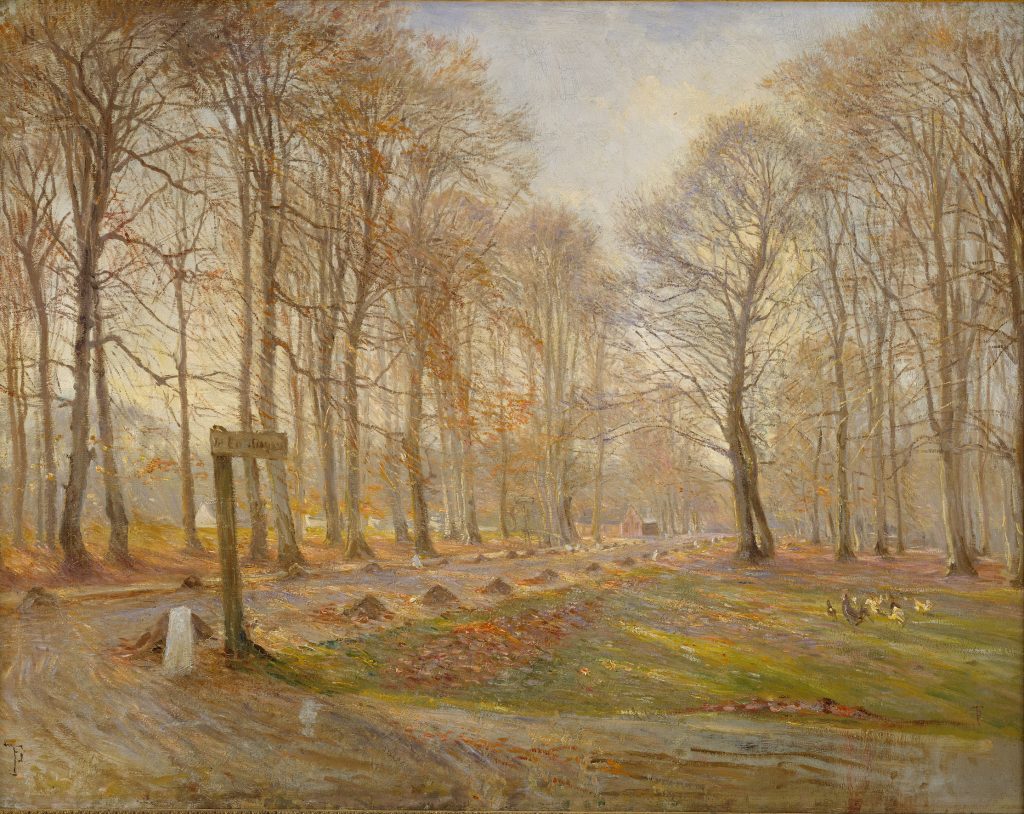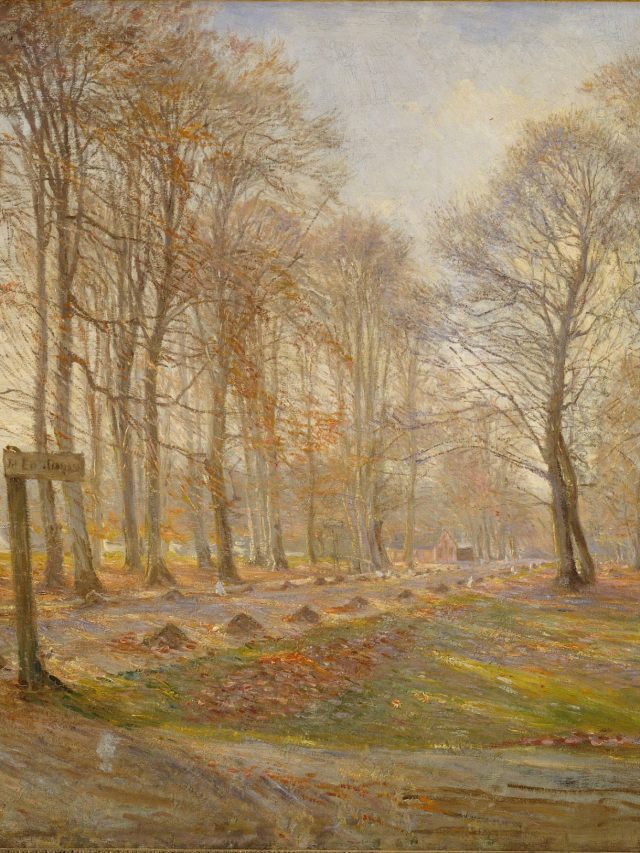Introduction
The heat and the sun of the summer months are gone, the nights come in and the wind has a cold edge, but the beauty of autumn is just beginning… One of the defining characteristics of the season is the new colours that fill the landscape with falling leaves turning red, yellow and orange. These fall scenes have inspired artists around the world for centuries, so sit back and take a look at 12 beautiful fall images that will make you yearn for cooler nights.
1. Saint Paul’s Hospital Garden (“Falling Leaves”), Vincent van Gogh, 1889
Vincent van Gogh often used his surroundings in his works and saw the beauty of the world even in the most turbulent times. For example, that painting was inspired by the large garden of the hospital where Vincent van Gogh entered in 1889. Amazed by the beauty of falling leaves, he originally called the painting “Falling Leaves”. In the work, the colours are earthy and cool, and we see a lonely figure surrounded by leaves in the wind.
2. Autumn leaves, Yokoyama Taikan, 1931
Yokoyama Taikan was responsible for popularising the nihong technique. A style that emerged around 1900 where works were made using traditional Japanese art practices and materials. This painting is one of the most impressive examples of his work. In the piece, Taikan painted most of the cosmos in ultramarine blue and added white silver dots in the form of clouds and rocks. The fresh blue contrasts with the red autumn leaves, which bring warmth to the scene. The result is a sensitive interpretation of the changing seasons.
3. Autumn on the Seine, Argenteuil (Automne sur la Seine Argenteuil) by Claude Monet, 1873
Claude Monet created this work shortly after arriving in Argenteuil in 1871. It presents the Petit Bras, a branch of the Seine. In the background, you can see recognisable architectural landmarks such as Château Michelet. Light, shadow and reflection are important qualities in Monet’s work, and in this case, his use of muted autumnal colours is reflected in the water below, resulting in an interesting symmetry. The reflection makes it difficult to distinguish between the reflected colours and their sources, which adds intrigue to the work.

4. Autumn colours, Kaii Higashiyama, 1986
Kaii Higashiyama is still one of the most respected contemporary Japanese painters. Higashiyama’s work is most striking in his use of colour and inspiration, which he draws from his deep admiration and respect for nature. In the last years of his life, the landscape painted by the artist was no longer from Japan or other parts of the world, but a deep expression of his inner world. That is why we are treated to such a variety of bold colour choices in this work, and perhaps because the focus is on plants and trees rather than recognisable buildings or landmarks.
5. Near Golden Autumn by Mstjora Kim N. Britov, 1999
Colours, atmosphere and energy are the main features of the work of Russian artist Kim N Britov. This work captures the landscape of Mstyora, a small village in the Vladimir Region, known as a centre of folk crafts. The traditional style of this country influenced Britov himself and it is reflected in the brightly coloured graphic style of his work. In this painting, Britov uses a palette of bright tones combined with large, deliberately harsh strokes to create a sunny, autumnal landscape full of energy. The paintings of the artist are mainly characterised by his emotional connection with the subject. That is why the sky in his pictures is so strikingly blue and the leaves are so bright orange. Even the church in the background looks golden at first glance.

6. Autumn by Helmer Osslund, 1907
This large painting was originally part of a series that captured the four seasons. Osslund was commissioned in 1907 to paint a series for Emil A. Matton (a great success in the leather industry) for his house in Gävle. When the building was demolished in 1979, the paintings were saved and the other three are now privately owned.
The calm water of the mountain lake can be seen behind the birches in the foreground. Osslund’s paintings are characterised by the reddish colours of autumn, and unlike the other works on this list, this one has an eerie darkness.
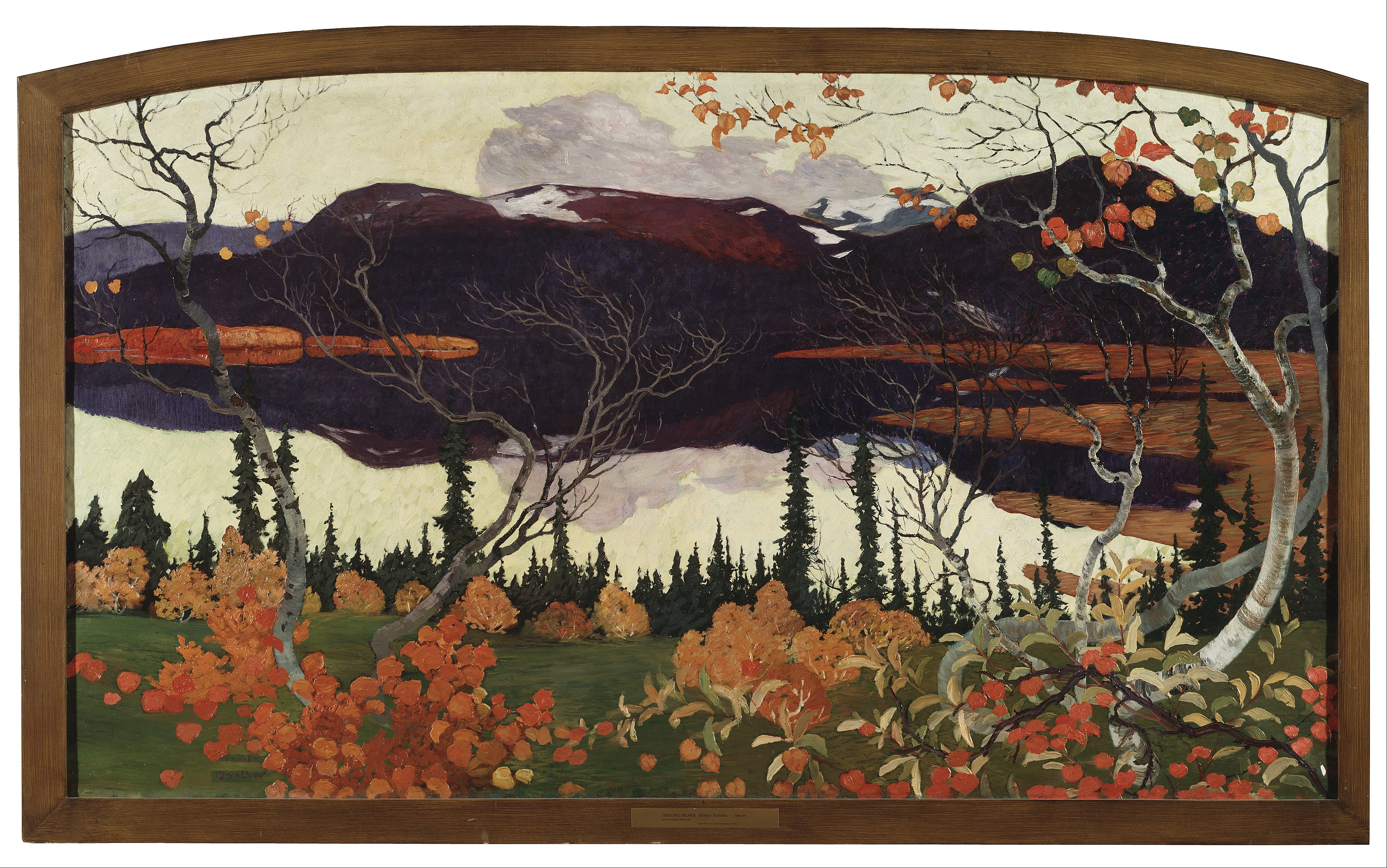
7. Canberra Civic Center Colonnades by Ethel Carrick Fox, 1944
Ethel Carrick Fox is known for her brightly coloured Post-Impressionist paintings of crowded streets, markets, cafes and beach scenes. This piece features the instantly recognisable buildings of central Canberra on a clear autumn day.
The yellow poplars and bicycles in the foreground further remind the viewer of their place, and Fox’s colourful brushwork captures the cool breeze and plenty of colours on a sunny fall day in the nation’s capital.
8. Inside Akiba Shrine, Ukeji, No. 91 One Hundred Famous Views of Edo by Hiroshige, 1857
Utagawa Hiroshige was a Japanese ukiyo-e artist and is considered the last great master of the tradition. In that Akiba shrine in the village of Ukeji, Hiroshige introduces a Western visual effect of the reflection of trees in water that could often be seen in the works of impressionist artists. The artist has carefully muted the reflected colours of the trees so that the green of the pines becomes brighter and the red of the maples becomes a soft pink. The red pigment used for the maples here differs from the red lead or iron oxide used in other works in the series, which turned black over time. Thanks to this, it is the only print where the original glory of autumn colours can still be fully appreciated.
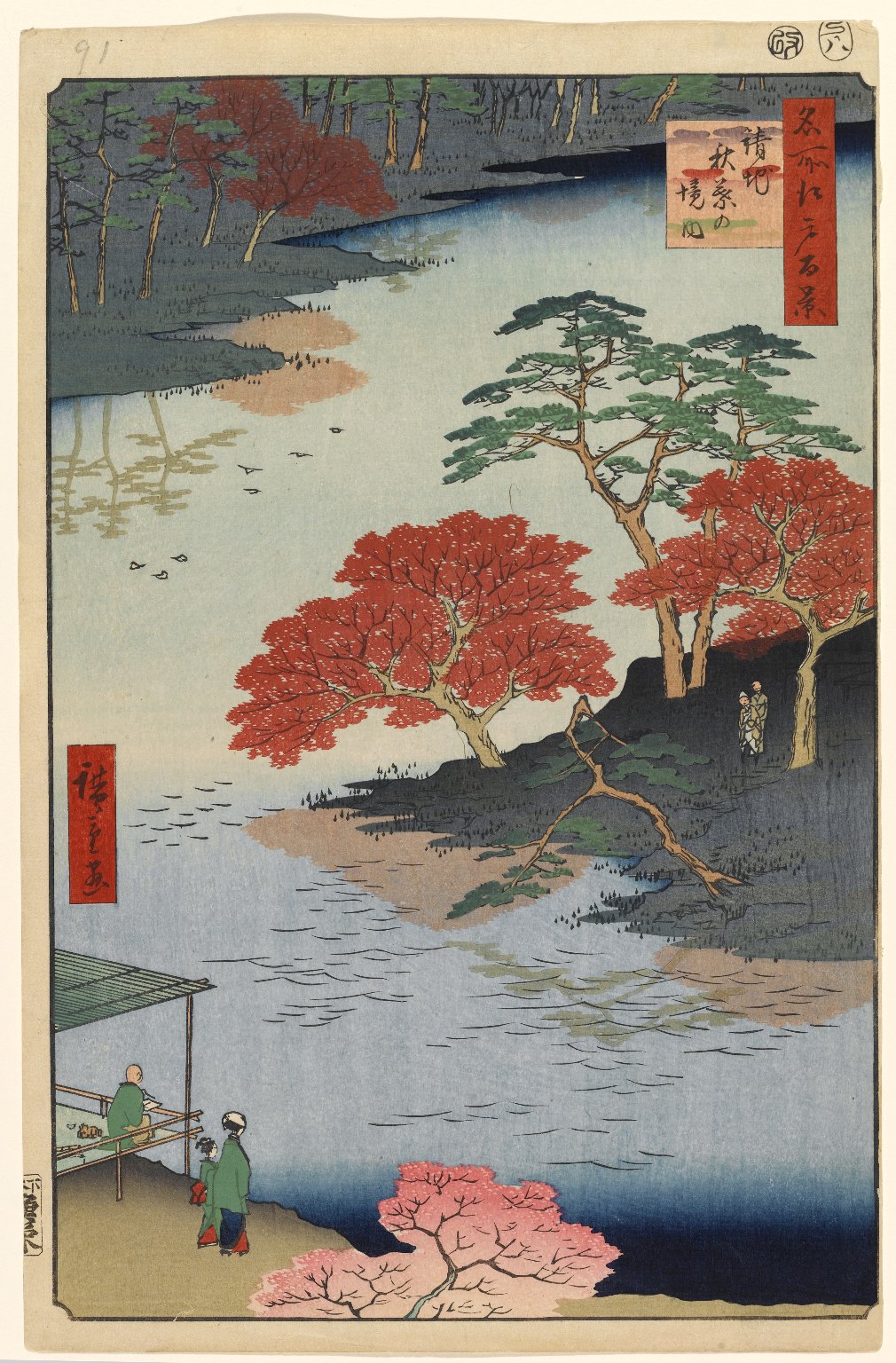
9. A Late Autumn Day in Jægersborg Deer Park, North of Copenhagen, by Theodor Philipsen, 1886
The Danish artist Theodor Philipsen was known for his paintings of landscapes and animals. In this painting, the artist captures the last days of autumn, as evidenced by his muddy colour palette and bare trees. This work differs slightly in style from Philipsen’s other works in that it is the first in which he used the brushwork technique of his friend and fellow artist Paul Gauguin. The pair became close during Gauguin’s trip to Copenhagen in the winter of 1884. In the piece, we see Philipsen use short, saturated brush strokes in complementary and contrasting colours, giving it an impressionistic aesthetic and maintaining the artist’s eye for detail.
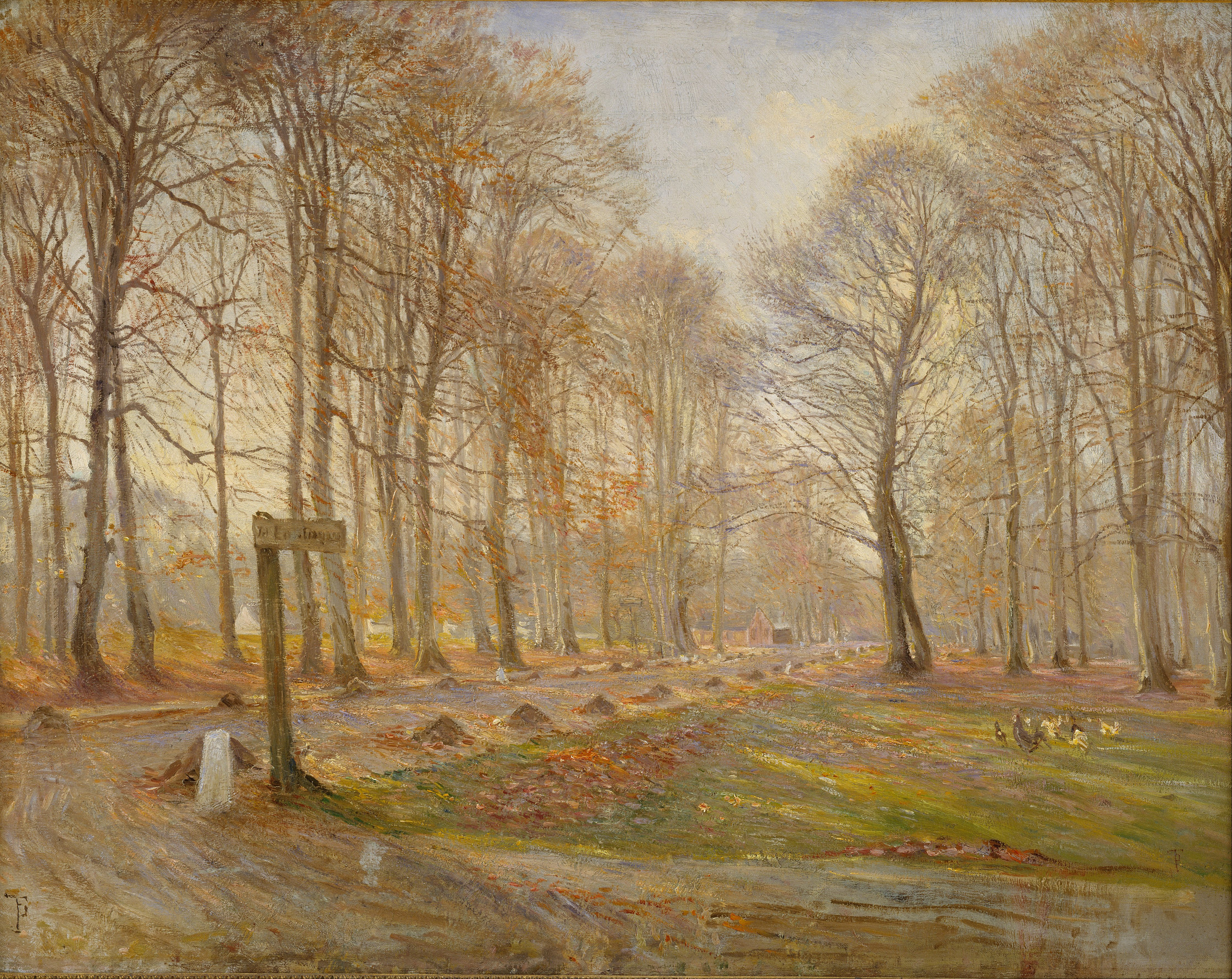
10. Autumn Landscape by Lin Fengmian, 1977
Lin Fengmian painted this piece the same year he settled in Hong Kong. Living in this new environment brought unexpected changes to his art. For example, it is believed that the freer social atmosphere gave him the courage to express stronger emotions in his work, which led to more expressive paintings. Therefore, coarse, bold brushwork and striking colours became the general characteristics of his later paintings. The landscapes of his time often take a step back from reality and, for example, in the Autumn Landscape, the perspective is somewhat distorted and seems almost chaotic. Rather than a precise interpretation of the subject, Fengmian focuses on expressive brushwork and vivid atmospheric colours to convey this rural landscape.

11. Starrucca Viaduct, Pennsylvania, Jasper Francis Cropsey, 1865
Jasper Francis Cropsey’s vision of this fiery fall captures the forests, mountains and valleys of the American Northeast, celebrating the country’s unique, unspoiled natural beauty. The imagery of railroads in this type of painting often symbolised the growth of American industry and was seen as both a sign of progress and the destruction of nature. For Cropsey, he took a more idealistic view of man’s relationship with the earth. In this painting, the train and stable blend easily into the surrounding landscape – the white smoke of the train echoes across the clouds – creating a peaceful scene of harmony between man and nature.
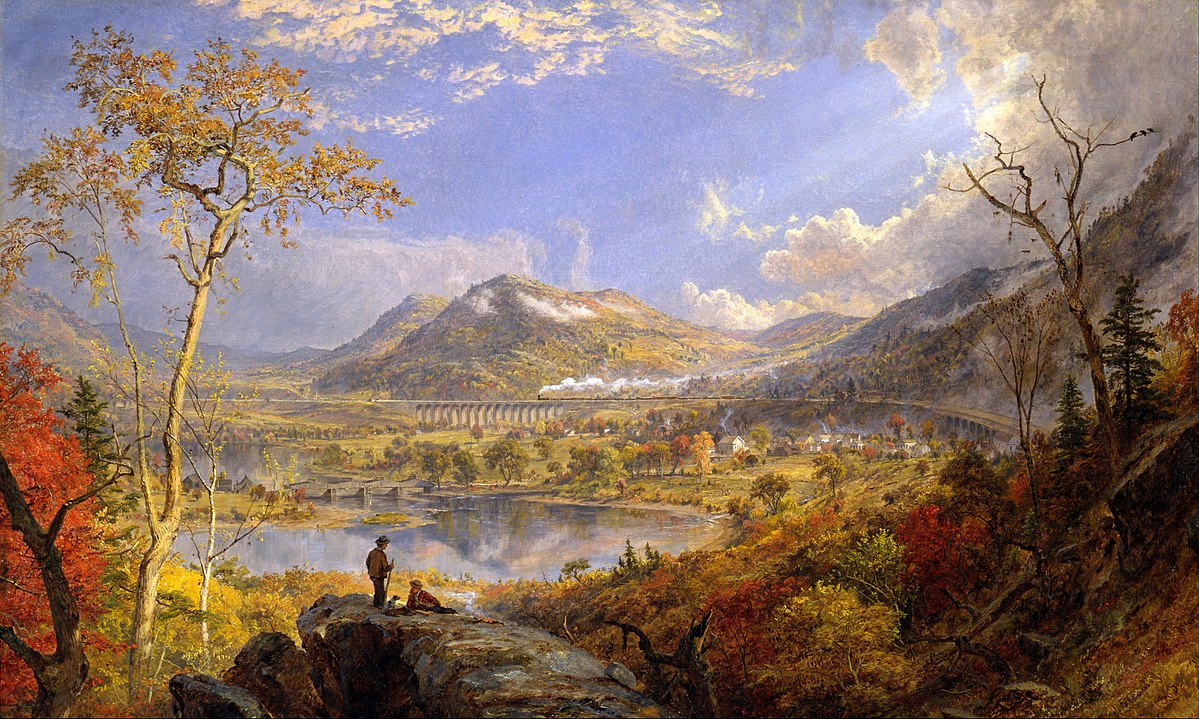
Conclusion
The allure of autumn has long been a wellspring of inspiration for artists from diverse corners of the world. As the warmth of summer gives way to cooler nights and the landscape transforms with a riot of red, yellow, and orange leaves, these artists have captured the essence of this season in their works. From Vincent van Gogh’s appreciation of falling leaves to the vibrant colours of Kaii Higashiyama’s Japanese landscapes, and from the tranquil scenes painted by Claude Monet to the expressive brushwork of Lin Fengmian, each artwork we explored truly stands for the profound impact of autumn on the creative spirit.
These paintings not only showcase the changing hues of nature but also reflect the unique perspectives and techniques of the artists themselves. Whether it’s the Impressionist use of light and reflection or the bold, emotional strokes of Russian artist Kim N. Britov, each piece tells a story of the artist’s connection to the world around them.
In essence, these 11 autumn scenes in art serve as a vivid reminder of the season’s timeless beauty and its ability to stir the human soul. As we contemplate these masterpieces, we can’t help but be drawn into the world of autumn, a season that continues to inspire and enchant us year after year.
Feature Image:A Late Autumn Day in Jægersborg Deer Park, North of Copenhagen, by Theodor Philipsen, 1886| Courtesy: Google Arts and Culture

Contributor


